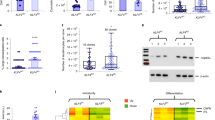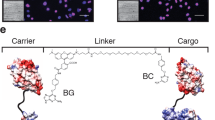Abstract
A number of genetic disorders are manifested in cutaneous epithelium and gene therapy approaches for treatment of such diseases are being considered. A successful gene therapy protocol requires durable and correctly targeted gene expression within the tissue. The continuous renewal and high levels of compartmentalization in epidermis are two challenges for a successful gene therapy of skin disorders. For those disorders which affect the upper layers of epidermis, vectors must be available that target stem cells, but remain silent until the progeny of these cells undergo differentiation. To explore the potential of long-term and targeted vector expression in epidermis, a hybrid retroviral vector encoding the reporter enhanced green fluorescent protein (EGFP) was constructed. The viral enhancer in the long terminal repeat of the vector was replaced with a 510-bp enhancer element of the human involucrin promoter. Keratinocyte-specific expression directed by the hybrid vector was demonstrated in culture and suprabasal-specific expression was observed in organotypic human epidermal cultures. In vivo transduction of mouse skin with this hybrid vector indicated long-term and stratum-specific expression of the transgene in mouse epidermis. The design of similar vectors for various gene therapy applications constitutes an important step toward clinically effective gene therapy.
This is a preview of subscription content, access via your institution
Access options
Subscribe to this journal
Receive 12 print issues and online access
$259.00 per year
only $21.58 per issue
Buy this article
- Purchase on Springer Link
- Instant access to full article PDF
Prices may be subject to local taxes which are calculated during checkout





Similar content being viewed by others
References
Khavari PA . Genetic correction of inherited epidermal disorders Hum Gene Ther 2000 11: 2277–2282
Hall PA, Watt FM . Stem cells: the generation and maintenance of cellular diversity Development 1989 106: 619–633
Robbins PB et al. In vivo restoration of laminin 5 beta 3 expression and function in junctional epidermolysis bullosa Proc Natl Acad Sci USA 2001 98: 5193–5198
Arin MJ, Longley MA, Wang X-J, Roop DR . Focal activation of a mutant allele defines the role of stem cells in mosaic disorders J Cell Biol 2001 152: 645–649
Mulligan RC . The basic science of gene therapy Science 1993 260: 926–932
Kolodka TM, Garlick JA, Taichman LB . Evidence for keratinocyte stem cells in vitro: long-term engraftment and persistence of transgene expression from retrovirus-transduced keratinocytes Proc Natl Acad Sci USA 1998 95: 4356–4361
Mathor MB et al. Clonal analysis of stably transduced human epidermal stem cells in culture Proc Natl Acad Sci USA 1996 93: 10371–10376
Miller N, Whelan J . Progress in transcriptionally targeted and regulatable vectors for genetic therapy Hum Gene Ther 1997 8: 803–815
Emerman M, Temin HM . Genes with promoters in retrovirus vectors can be independently supressed by an epigenic mechanism Cell 1984 39: 459–467
Diaz RM, Eisen T, Hart IR, Vile RG . Exchange of viral promoter/enhancer elements with heterologous regulatory sequences generates targeted hybrid long terminal repeat vectors for gene therapy of melanoma J Virol 1998 72: 789–795
Grande A et al. Transcriptional targeting of retroviral vectors to the erythroblastic progeny of transduced hematopoietic stem cells Blood 1999 93: 3276–3285
Rice RH, Green H . Presence in human epidermal cells of a soluble protein precursor of the cross-linked envelope: activation of the cross-linking by calcium ions Cell 1979 18: 681–694
Crish JF et al. Tissue-specific and differentiation-appropriate expression of the human involucrin gene in transgenic mice: an abnormal epidermal phenotype Differentiation 1993 53: 191–200
Carroll JM et al. Tissue- and stratum-specific expression of the human involucrin promoter in transgenic mice Proc Natl Acad Sci USA 1993 90: 10270–10274
Efimova T, LaCelle P, Welter JF, Eckert RL . Regulation of human involucrin promoter activity by a protein kinase C, Ras, MEKK1, MEK3, p38/RK, AP1 signal transduction pathway J Biol Chem 1998 273: 24387–24395
Banks EB, Crish JF, Eckert RL . Transcription factor Sp1 activates involucrin promoter activity in non-epithelial cell types Biochem J 1999 337: 507–512
Crish JF, Zaim TM, Eckert RL . The distal regulatory region of the human involucrin promoter is required for expression in epidermis J Biol Chem 1998 273: 30460–30465
Burns JC et al. Vesicular somatitis virus G glycoprotein pseudotyped retroviral vectors: concentration to very high titer and efficient gene transfer into mammalian and nonmammalian cells Proc Natl Acad Sci USA 1993 90: 8033–8037
Banks-Schlegel S, Green H . Involucrin synthesis and tissue assembly by keratinocytes in natural and cultured human epithelia J Cell Biol 1981 90: 732–737
Ghazizadeh S, Harrington R, Taichman LB . In vivo transduction of mouse epidermis with recombinant retroviral vectors: implications for cutaneous gene therapy Gene Therapy 1999 6: 1267–1275
Potten CS . Cell replacement in epidermis (keratopoiesis) via discrete units of proliferation Int Rev Cytol 1981 69: 271–318
Li ER, Owens DM, Djian P, Watt FM . Expression of involucrin in normal, hyperproliferative and neoplastic mouse keratinocytes Exp Dermatol 2000 9: 431–438
Zhan HC, Liu DP, Liang CC . Insulator: from chromatin domain boundary to gene regulation Hum Genet 2001 109: 471–478
Ghazizadeh S, Carroll JM, Taichman LB . Repression of retrovirus-mediated transgene expression by interferons: implications for gene therapy J Virol 1997 71: 9163–9169
Miller AD . Retroviral vectors Curr Topics Microbiol Immunol 1992 158: 3–24
Kaptein LC, Breuer M, Valerio D, van Bensechem VW . Expression pattern of CD2 locus control region containing retroviral vectors in hemopoietic cells in vitro and in vivo Gene Therapy 1998 5: 320–330
Sinha S, Degenstein L, Copenhaver C, Fuchs E . Defining the regulatory factors required for epidermal gene expression Mol Cell Biol 2000 20: 2543–2555
Kinsella TM, Nolan GP . Episomal vectors rapidly and stably produce high-titer recombinant retrovirus Hum Gene Ther 1996 7: 1405–1413
Pear WS, Nolan GP, Scott ML, Baltimore D . Production of high-titer helper-free retroviruses by transient transfection Proc Natl Acad Sci USA 1993 90: 8392–8396
Rheinwald JG, Green H . Serial cultivation of strains of human epidermal keratinocytes: the formation of keratinocyte colonies from single cells Cell 1975 6: 331–344
Wu Y-J et al. The mesothelial keratins: a new family of cytoskeletal proteins identified in cultured mesothelial cells nonkeratinizing epithelia Cell 1982 31: 693–703
Acknowledgements
We are grateful to Robin Harrington and Ning Lin for technical assistance. This research was supported by grants from the NIH to LT (R01-DE04511) and to SG (K01-AR02100).
Author information
Authors and Affiliations
Rights and permissions
About this article
Cite this article
Ghazizadeh, S., Doumeng, C. & Taichman, L. Durable and stratum-specific gene expression in epidermis. Gene Ther 9, 1278–1285 (2002). https://doi.org/10.1038/sj.gt.3301800
Received:
Accepted:
Published:
Issue Date:
DOI: https://doi.org/10.1038/sj.gt.3301800
Keywords
This article is cited by
-
Distinct Strategies Are Required to Suppress Antigen-specific Responses to Genetically Modified Keratinocytes and Fibroblasts
Molecular Therapy (2012)
-
Transgenic mouse model expressing tdTomato under involucrin promoter as a tool for analysis of epidermal differentiation and wound healing
Transgenic Research (2012)
-
Ex-vivo Gene Therapy Restores LEKTI Activity and Corrects the Architecture of Netherton Syndrome-derived Skin Grafts
Molecular Therapy (2011)
-
Increased interstitial pressure improves nucleic acid delivery to skin enabling a comparative analysis of constitutive promoters
Gene Therapy (2010)
-
Loss of Transgene following ex vivo Gene Transfer is Associated with a Dominant Th2 Response: Implications for Cutaneous Gene Therapy
Molecular Therapy (2007)



